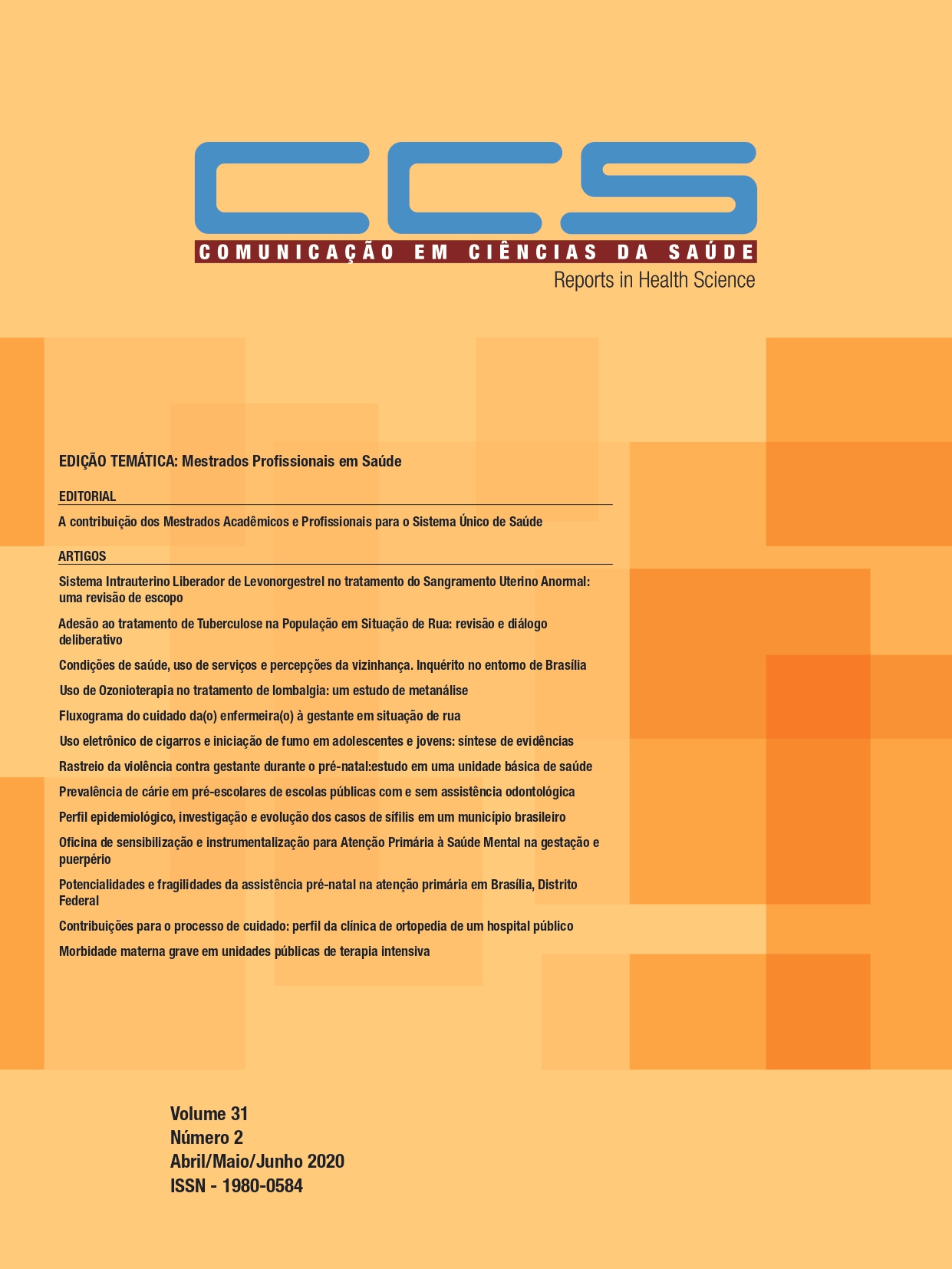Several maternal morbidity in public intensive care units in Brazil's capital
epidemiological and clinical aspects
DOI:
https://doi.org/10.51723/ccs.v31i02.626Keywords:
Severe maternal morbidity, Morbidity, Epidemiology, Mortality, Near MissAbstract
Objective: To evaluate the epidemiological and clinical aspects of severe morbidity and maternal near miss. Materials and Methods: This cross-sectional, descriptive and analytical study with logistic regression was conducted in seven public intensive care units between 2011 and 2013. Results: Hemorrhage was the most frequent complication in women in the third and fourth decade of life, followed by hypertension; those conditions have increased the risk of death and delay in intervention. Conclusion: The high number of maternal near misses needs further risk assessment studies in obstetric emergencies to identify rapidly maternal complications.
Downloads
References
Alkema L, Chou D, Houga D, Zhang S, Moller AB, Gemmill A, et al. Global, regional, and national levels and trends in maternal mortality between 1990 and 2015, with scenario-based projections to 2030: a systematic analysis by the UN Maternal Mortality Estimation Inter-Agency Group. Lancet [Internet]. 2016; 387(10017):462-74. Available from: https://www.ncbi.nlm.nih.gov/pubmed/26584737. DOI: 10.1016/S0140-6736(15)00838-7.
World Health Organization. Newborn health action plan: WHA67.10. In: Sixty-Seventh World Health Assembly [Internet]. Geneva: WHO; 2014:19-20. Available from: http://apps.who.int/gb/ebwha/pdf_files/WHA67-REC1/A67_2014_REC1-en.pdf.
Say L, Souza JP, Pattinson RC, WHO Working Group on Maternal Mortality Morbidity Classifications. Maternal near miss--towards a standard tool for monitoring quality of maternal health care. Best Pract Res Clin Obstet Gynaecol [Internet]. 2009;23(3):287-96. DOI: 10.1016/j.bpobgyn.2009.01.007.
Tunçalp O, Hindin MJ, Souza JP, Chou D, Say L. The prevalence of maternal near miss: a systematic review. BJOG [Internet]. 2012;119(6):653-61. Available from: http://onlinelibrary.wiley.com/doi/10.1111/j.14710528.2012.03294.x/abstract;jsessionid=9FC2718A36B3BCE668372DF98D6892C9.f03t04. DOI: 10.1111/j.1471-0528.2012.03294.x
Souza JP, Cecatti JG, Faundes A, Morais SS, Villar J, Carroli G, et al. Maternal near miss and maternal death in the World Health Organization's 2005 global survey on maternal and perinatal health. Bull World Health Organ [Internet]. 2010; 88(2):113-9. Available from: https://www.ncbi.nlm.nih.gov/pmc/articles/PMC2814475/pdf/08-057828.pdf. DOI: 10.2471/BLT.08.057828.
World Health Organization. Evaluating the quality of care for severe pregnancy complications: The WHO near-miss approach for maternal health [Internet]. Geneva: WHO; 2011. Available from: http://apps.who.int/iris/bitstream/10665/44692/1/9789241502221_eng.pdf.
Lotufo FA, Parpinelli MA, Haddad SM, Surita FG, Cecatti JG. Applying the new concept of maternal near-miss in an intensive care unit. Clinics (São Paulo) [Internet]. 2012;67(3):225-30. Available from: https://www.revistas.usp.br/clinics/article/viewFile/19658/21722. DOI: 10.6061/clinics/2012(03)04.
Amorim MM, Katz L, Valenca M, Araujo DE. Severe maternal morbidity in an obstetric ICU in Recife, Northeast of Brazil. Rev Assoc Med Bras [Internet]. 2008; 54(03):261-6. Available from: http://www.scielo.br/scielo.php?script=sci_arttext&pid=S0104-42302008000300021.
Souza JP, Cecatti JG, Parpinelli MA, de Sousa MH, Serruya SJ. Revisão sistemática sobre morbidade materna: near miss. Cad Saúde Pública [Internet]. 2006;22(2):255-64. Disponível em: http://www.scielo.br/scielo.php?script=sci_arttext&pid=S0102-311X2006000200003.
Soares FM, Pacagnella RC, Tunçalp Ö, et al. Provision of intensive care to severely ill pregnant women is associated with reduced mortality: Results from the WHO Multicountry Survey on Maternal and Newborn Health. Int J Gynaecol Obstet [Internet]. 2020; 10.1002/ijgo.13241. Available from: https://doi.org/10.1002/ijgo.13241
Governo do Distrito Federal; Subsecretaria de Vigilância à Saúde [Internet]. Brasília: Secretaria de Estado de Saúde do DF; 2014. Relatório epidemiológico sobre óbitos maternos no Distrito Federal. Disponível em: http://www.saude.df.gov.br/wp-conteudo/uploads/2018/03/Relatorio_natalidade_2014.pdf
Tunçalp O, Hindin MJ, Adu-Bonsaffoh K, Adanu RM. Understanding the Continuum of Maternal Morbidity in Accra, Ghana. Matern Child Health J [Internet]. 2014;18(7):1648-57. Available from: https://link.springer.com/article/10.1007%2Fs10995-013-1405-8.
Cecatti JG, Souza RT, Pacagnella RC, Leal MC, Moura EC, Santos LMP. Maternal near miss among women using the public health system in the Amazon and Northeast regions of Brazil. Rev Panam Salud Publica. 2015;37(4-5):232-8.
Rocha Filho EA, Costa ML, Cecatti JG, Parpinelli MA, Haddad SM, Sousa MH, et al. Contribution of antepartum and intrapartum hemorrhage to the burden of maternal near miss and death in a national surveillance study. Acta Obstet Gynecol Scand [Internet]. 2014;94(1):50-58. Available from: http://europepmc.org/abstract/med/25327163. DOI: 10.1111/aogs.12529.
Galvao LPL, Alvim-Pereira F, de Mendonca CM, Menezes FEF, Gois KAN, Ribeiro RF Jr, et al. The prevalence of severe maternal morbidity and near miss and associated factors in Sergipe, Northeast Brazil. BMC Pregnancy Childbirth [Internet]. 2014; 14:25. Available from: https://bmcpregnancychildbirth.biomedcentral.com/articles/10.1186/1471-2393-14-25. DOI: 10.1186/1471-2393-14-25.
Madeiro AP, Rufino AC, Lacerda EZ, Brasil LG. Incidence and determinants of severe maternal morbidity: a transversal study in a referral hospital in Teresina, Piauí, Brazil. BMC Pregnancy Childbirth. 2015;15:210. Available from: https://www.ncbi.nlm.nih.gov/pmc/articles/PMC4562200/. DOI: 10.1186/s12884-015-0648-3.
Karolinski A, Mercer R, Micone P, Ocampo C, Mazzoni A, Fontana O, et al. The epidemiology of life-threatening complications associated with reproductive process in public hospitals in Argentina. BJOG [Internet]. 2013;120(13):1685-94;discussion 944-5. Available from: http://onlinelibrary.wiley.com/doi/10.1111/1471-0528.12395/pdf. DOI: 10.1111/1471-0528.12395.
Roost M, Altamirano VC, Liljestrand J, Essen B. Priorities in emergency obstetric care in Bolivia--maternal mortality and near-miss morbidity in metropolitan La Paz. BJOG [Internet]. 2009;116(9):1210-7. Available from: http://onlinelibrary.wiley.com/doi/10.1111/j.1471-0528.2009.02209.x/abstract. DOI: 10.1111/j.1471-0528.2009.02209.x.
David E, Machungo F, Zanconato G, Cavaliere E, Fiosse S, Sululu C, et al. Maternal near miss and maternal deaths in Mozambique: a cross-sectional, region-wide study of 635 consecutive cases assisted in health facilities of Maputo province. BMC Pregnancy Childbirth [Internet]. 2014;14:401. Available from: https://www.ncbi.nlm.nih.gov/pmc/articles/PMC4269100/. DOI: 10.1186/s12884-014-0401-3.
Cirelli J, Surita F, Costa M L, Parpinelli MA, Haddad S, Cecatti JG. The Burden of Indirect Causes of Maternal Morbidity and Mortality in the Process Of Obstetric Transition: A Cross-Sectional Multicenter Study. Rev. Bras. Ginecol. Obstet. [Internet]. 2018; 40(3):106-114 Available from: https://doi.org/10.1055/s-0038-1623511
Downloads
Published
Issue
Section
License
Declaro para os devidos fins que o artigo que estou submetendo representa um trabalho original e nunca foi publicado total ou parcialmente, e que se alguma de suas partes foi publicada possuímos autorização expressa para a publicação no periódico Comunicação em Ciências da Saúde (CCS). Esse artigo não foi enviado a outro periódico e não o será enquanto estiver sendo considerada sua publicação; caso venha a ser aceito não será publicado em outro periódico; e não contém material difamatório ou ilegal sob nenhuma forma, não viola a intimidade de terceiros, nem infringe direitos protegidos.
Eu e demais autores desse trabalho certificamos por meio desta declaração que:
- Concordamos com as normas editoriais e com o processo de revisão da CCS;
- Aceitamos a responsabilidade pela conduta desse estudo e pela análise e interpretação dos dados;
- Cooperaremos, sempre que solicitado, na obtenção e fornecimento de dados sobre os quais o manuscrito está baseado, para exame dos avaliadores;
- Não estão sendo omitidos quaisquer ligações ou acordos de financiamento entre os autores e companhias ou pessoas que possam ter interesse no material abordado no artigo;
- Não estão sendo excluídos ou omitidos deste artigo autores ou instituições participantes;
- Possuímos permissão para uso de figuras e tabelas publicadas em outras fontes;
- Possuímos permissão das pessoas e instituições citadas nos agradecimentos;
- O autor correspondente autoriza a publicação do endereço informado e e-mail do(s) autor(es) junto com o artigo;
- Assumimos a responsabilidade pela entrega de documentos verídicos;
- Autorizamos a publicação do referido artigo no periódico Comunicação em Ciências da Saúde, segundo critérios próprios e em número e volume a serem definidos pelo editor do periódico;
- Nos comprometemos a atender os prazos estipulados pelos editores do periódico Comunicação em Ciências da saúde;
- Estamos cientes de que a não manifestação no prazo de dois dias da revisão da diagramação, recebida por e-mail, será considerado aprovado para publicação.








